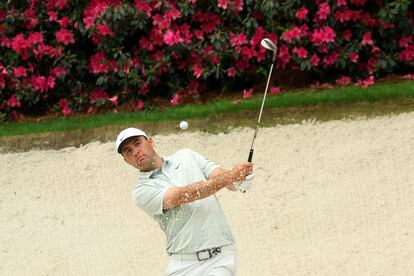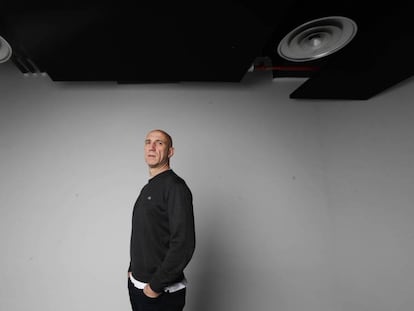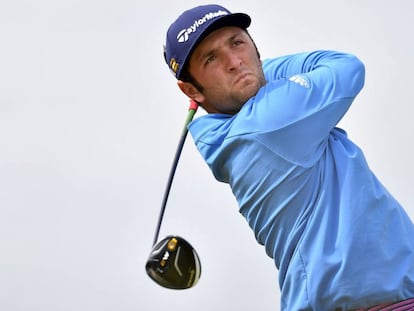The ‘cubs’ of golfing legend Tiger Woods are taking over the game
The twentysomethings who were in diapers during the star player’s heyday are now topping the world rankings

It is still dark when hundreds of golf fans at the 2022 Masters Tournament at Augusta gather around a tee to create a human walkway from the clubhouse to the Big Oak. As the sun comes up, three golfing legends parade down it to applause from the crowd. They walk slowly, as if savoring their moment of glory. Once champions, they are now honorary starters, in charge of teeing off in the season’s first major tournament. This year, it was the turn of Gary Player, 86, Jack Nicklaus, 82 and Tom Watson, 72, to don the player’s glove once more and kick off the 86th Masters on April 7. The tradition is a nod to the past in a sport that is being rejuvenated; a physically compromised Tiger Woods may be trying to make a comeback at 46, but there are seven twentysomethings among the world’s top 10 competitors vying for the cup.
At the end of last month, the American Dustin Johnson, 37, dropped out of the world’s top 10. That Monday, March 21, the lowest average age ever among the top 10 was recorded in a ranking that was established in 1986: 27.71 years. And although Johnson has bounced back to reclaim his place among the elite, much younger competitors are biting at his heels. Scottie Scheffler needed only 42 days after his first victory on the American circuit to top the rankings at the age of 25. He pushed Spaniard Jon Rahm, 27, into second position, who is followed by Collin Morikawa, 25, and Viktor Hovland, 24. Patrick Cantlay, 30, completes the top five in the world today, while Cameron Smith and Justin Thomas, both 28, are ahead of Johnson, Rory McIlroy, 32, and Xander Schauffele, 28 when it comes to the top 10.
Golf has long allowed players to compete well into their 40s: Nicklaus won his 18th major championship at 46, the same age as Woods is now. But the game has got considerably younger in recent years and can even be compared with tennis, in which there are eight 20-year-olds in the top 10 – Novak Djokovic at 34 and Rafa Nadal at 35 are still among the elite but Roger Federer and Serena Williams are still competing at age 40.
The interview with Kepa ☺️ pic.twitter.com/Qvlsa2dZ83
— Tracking Jon Rahm (@TrackingRahm) April 6, 2022
“The training given to young people by universities is key,” explains José María Olazabal, who at 56 is still passionate about the Masters, although he recognizes his time is well over. The Basque golfer, who won the “Green Jacket” in 1994 and 99, suffers from tendinitis that he treats with corticoids and ice. From the sidelines, he observes how the training of young golfers has improved – if they are trained hard during adolescence, they reach the top earlier. “It’s been the trend for quite some time,” he says. “It’s unstoppable. Today any young golfer is very well-prepared both physically and mentally, and we should see greater degrees of sporting longevity. Besides, the knowledge they have of the game is much greater than we had.”
According to Olazabal, this sea change is down to the fact that US universities have become factories churning out future champions. Jon Rahm, for example, emerged from the University of Arizona, to become the world’s number one amateur, catapulting him onto the professional circuit. Meanwhile, the University of Oklahoma – from which Rickie Fowler, Matthew Wolff and Viktor Hovland emerged – is training up Eugenio López-Chacarra, a 20-year-old finance student from Madrid who is already fourth in the world amateur rankings.
“We young people are hungrier,” explains Chacarra from his university campus, where he is constantly signing autographs after his performance at Augusta Haskins, a university tournament in which he came second. “We train more and we want to get to the top. In the US, there is a lot of competition, a lot of rivalry. You have to play extremely well because your teammates are the best in the world. There are four golfers from the United States on my team and nine others from abroad. They treat us as if we were from Madrid or Barça [soccer teams]. We can have anything we want. I have a physio, two physical trainers, two golf coaches, a nutritionist, a mindset coach, biomechanical studies, all the technology – everything you can imagine to reach the elite,” adds the Spanish hopeful, who plans to make the leap to the professional circuit next June. Another star in the making is Jorge Hao, 15, from Madrid who trains in Spain and is the European Under-16 champion and, like Rahm at the same age, Spanish Under-18 champion.
Tiger’s legacy
The Masters has often been a land where experience rules and scars count. Since 1958, when Arnold Palmer became the first twentysomething to wear the green jacket, the average age of the winners has taken years to go down. But now Tiger Woods struggles to convince that experience, scars and grey hair matter. Increasingly, he is the exception, not the rule – even more so Phil Mickelson, who won the last PGA (Professional Golfers Association) Championship at the age of 50, an all-time record in the major tournaments. Today those who rule are Tiger’s “cubs,” those golfers who have grown up admiring his achievements and who owe a good part of the investment being plowed into them to the fact he took golf into a whole new dimension.
Woods was 21 when he played and won his first championship, the Masters at Augusta. When he donned the green jacket on April 13, 1997, Jon Rahm was two years old; Scheffler, the current number one, was 10 months old; Morikawa was two; and Hovland was not even born. Now, these youngsters are claiming the game as theirs.
Tu suscripción se está usando en otro dispositivo
¿Quieres añadir otro usuario a tu suscripción?
Si continúas leyendo en este dispositivo, no se podrá leer en el otro.
FlechaTu suscripción se está usando en otro dispositivo y solo puedes acceder a EL PAÍS desde un dispositivo a la vez.
Si quieres compartir tu cuenta, cambia tu suscripción a la modalidad Premium, así podrás añadir otro usuario. Cada uno accederá con su propia cuenta de email, lo que os permitirá personalizar vuestra experiencia en EL PAÍS.
¿Tienes una suscripción de empresa? Accede aquí para contratar más cuentas.
En el caso de no saber quién está usando tu cuenta, te recomendamos cambiar tu contraseña aquí.
Si decides continuar compartiendo tu cuenta, este mensaje se mostrará en tu dispositivo y en el de la otra persona que está usando tu cuenta de forma indefinida, afectando a tu experiencia de lectura. Puedes consultar aquí los términos y condiciones de la suscripción digital.
More information
Últimas noticias
Most viewed
- Sinaloa Cartel war is taking its toll on Los Chapitos
- Oona Chaplin: ‘I told James Cameron that I was living in a treehouse and starting a permaculture project with a friend’
- Reinhard Genzel, Nobel laureate in physics: ‘One-minute videos will never give you the truth’
- Why the price of coffee has skyrocketed: from Brazilian plantations to specialty coffee houses
- Silver prices are going crazy: This is what’s fueling the rally











































